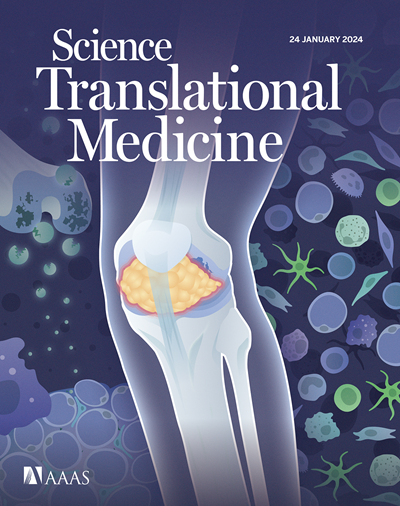Synthetic biology–driven induction of mature TLS formation enhances antitumor immunity in colorectal cancer
IF 15.8
1区 医学
Q1 CELL BIOLOGY
引用次数: 0
Abstract
The efficacy of immunotherapy in colorectal cancer (CRC) hinges upon a comprehensive understanding of how the immune system interacts with tumor cells within the colorectal microenvironment. Mature tertiary lymphoid structures (mTLSs) are associated with an increased objective response rate, progression-free survival, and overall survival in patients with CRC. Thus, it has been suggested that increasing mTLSs in the context of CRC could improve patient outcomes. However, no established method to specifically induce TLS maturation within and around tumor sites is available. To address this gap in technology, we engineered a Salmonella typhimurium strain, SLCVNP20009, to express tumor necrosis factor (TNF) superfamily member 14 (TNFSF14, also called LIGHT). This strain colonized tumors and released LIGHT, which then formed a ligand-receptor pair with herpes virus entry mediator (HVEM) to induce a powerful cellular immune response. Furthermore, this engineered microbe modulated the proportions of intestinal innate lymphoid cells (ILCs), which serve an anti-infection role in innate immunity. Mice that were deficient in HVEM or ILC3 exhibited fewer mTLSs, a greater bacterial burden, and increased mortality in two different models of CRC. Thus, this engineered microbe with enhanced immunogenic properties demonstrated the potential to stimulate mTLS-associated antitumor immune responses in the colon and was well tolerated in vivo. Our results indicate that LIGHT-HVEM signaling on group 3 ILCs (ILC3s) is crucial for mTLS formation and T cell–mediated antitumor immunity in CRC and additionally suggest a synbiotic-based therapeutic approach for the management of CRC.
合成生物学诱导成熟TLS形成增强结直肠癌的抗肿瘤免疫
免疫治疗在结直肠癌(CRC)中的疗效取决于对免疫系统如何与结直肠微环境中的肿瘤细胞相互作用的全面理解。成熟的三级淋巴结构(mTLSs)与CRC患者客观缓解率、无进展生存期和总生存期的增加有关。因此,有研究表明,在结直肠癌的背景下,增加mtss可以改善患者的预后。然而,目前还没有明确的方法来诱导肿瘤部位内和周围的TLS成熟。为了解决这一技术差距,我们设计了一种鼠伤寒沙门氏菌菌株SLCVNP20009来表达肿瘤坏死因子(TNF)超家族成员14 (TNFSF14,也称为LIGHT)。该菌株定植肿瘤并释放LIGHT,然后与疱疹病毒进入介质(HVEM)形成配体-受体对,诱导强大的细胞免疫反应。此外,这种工程微生物调节肠道先天淋巴样细胞(ILCs)的比例,在先天免疫中起抗感染作用。在两种不同的结直肠癌模型中,缺乏HVEM或ILC3的小鼠表现出更少的mtss,更大的细菌负担和更高的死亡率。因此,这种具有增强免疫原性的工程微生物证明了在结肠中刺激mtls相关的抗肿瘤免疫反应的潜力,并且在体内具有良好的耐受性。我们的研究结果表明,3组ILCs (ILC3s)上的LIGHT-HVEM信号对于mTLS的形成和CRC中T细胞介导的抗肿瘤免疫至关重要,并且还为CRC的治疗提供了一种基于合成的治疗方法。
本文章由计算机程序翻译,如有差异,请以英文原文为准。
求助全文
约1分钟内获得全文
求助全文
来源期刊

Science Translational Medicine
CELL BIOLOGY-MEDICINE, RESEARCH & EXPERIMENTAL
CiteScore
26.70
自引率
1.20%
发文量
309
审稿时长
1.7 months
期刊介绍:
Science Translational Medicine is an online journal that focuses on publishing research at the intersection of science, engineering, and medicine. The goal of the journal is to promote human health by providing a platform for researchers from various disciplines to communicate their latest advancements in biomedical, translational, and clinical research.
The journal aims to address the slow translation of scientific knowledge into effective treatments and health measures. It publishes articles that fill the knowledge gaps between preclinical research and medical applications, with a focus on accelerating the translation of knowledge into new ways of preventing, diagnosing, and treating human diseases.
The scope of Science Translational Medicine includes various areas such as cardiovascular disease, immunology/vaccines, metabolism/diabetes/obesity, neuroscience/neurology/psychiatry, cancer, infectious diseases, policy, behavior, bioengineering, chemical genomics/drug discovery, imaging, applied physical sciences, medical nanotechnology, drug delivery, biomarkers, gene therapy/regenerative medicine, toxicology and pharmacokinetics, data mining, cell culture, animal and human studies, medical informatics, and other interdisciplinary approaches to medicine.
The target audience of the journal includes researchers and management in academia, government, and the biotechnology and pharmaceutical industries. It is also relevant to physician scientists, regulators, policy makers, investors, business developers, and funding agencies.
 求助内容:
求助内容: 应助结果提醒方式:
应助结果提醒方式:


